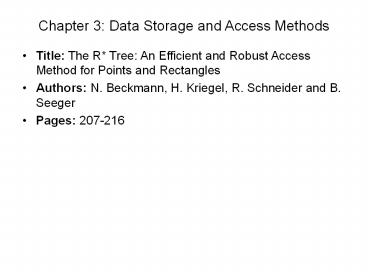Chapter 3: Data Storage and Access Methods - PowerPoint PPT Presentation
Title:
Chapter 3: Data Storage and Access Methods
Description:
Large geographic data. ... Large rectangles limit split options! Non ... Insertions and deletions. Overlapping directory rectangles = multiple search paths ... – PowerPoint PPT presentation
Number of Views:121
Avg rating:3.0/5.0
Title: Chapter 3: Data Storage and Access Methods
1
Chapter 3 Data Storage and Access Methods
- Title The R Tree An Efficient and Robust
Access Method for Points and Rectangles - Authors N. Beckmann, H. Kriegel, R. Schneider
and B. Seeger - Pages 207-216
2
The R Tree An Efficient and Robust Access
Method for Points and Rectangles
- Problem
- Problem Statement
- Why is this problem important?
- Why is this problem hard?
- Approaches
- Approach description, key concepts
- Contributions (novelty, improved)
- Assumptions
3
Problem Statement R Tree
- Given
- Data containing points and rectangles
- Spatial queries (point, range query, insert,
delete) - Find - An Access Method (Data Structure)
- A hierarchical organization of rectangles
- Example from wikipedia
- Objectives
- Efficiency of spatial queries
- Constraints
- Balanced tree
- Each node is a disk page and has gt m (min of
entries) entries. - Root has at least two children unless it is a
leaf - Efficiency metric number of disk-pages accessed
4
Why is this problem important?
- Multi-dimensional Applications
- Large geographic data. e.g., Map objects like
countries occupy regions of non-zero size in two
dimension. - Common real world usage Find all museums within
2 miles of my current location". - CAD
- Many DBMS servers support spatial indices
- Orcale, IBM DB2,
5
Why is this problem Hard?
- B-tree split methods ineffective in 2-dimensions
- Ex. Sorting
- Size variation across data Rectangles
- Large rectangles limit split options!
- Non-uniform data distribution over space
- Dynamic Access Method
- Insertions and deletions
- Overlapping directory rectangles gt multiple
search paths
6
Novelty of Contribution
- Related Work
- Traditional one-dimensional indexing structures
(e.g., hash, B-tree) are not appropriate for
range search - B tree
- Represents sorted data in a way that allows for
efficient insertion and removal of elements. - Dynamic, multilevel index with maximum and
minimum bounds on the number of keys in each
node. - Leaf nodes are linked together as a linked list
to make range queries easy. - R-tree
- R-tree is a foundation for spatial access method
- A complex spatial object is represented by
minimum bounding rectangles while preserving
essential geometric properties - Over-lapping regions
- Heuristic minimize the area of each enclosing
rectangle in the inner nodes.
7
Principles of R-tree
- Height-balanced tree similar to a B-tree with
index records in its leaf nodes containing
pointers to data objects. - Heuristic Optimization minimize the area of each
enclosing rectangle in the inner nodes.
Reference A Guttman R-tree a dynamic index
structure for spatial searching, 1984
8
Performance Parameters beyond R-tree
- (Q1) The area covered by a directory rectangle
should be minimized. - (Q2) The overlap between directory rectangles
should be minimized. - (Q3) The margin of a directory rectangle should
be minimized. - (Q4) Storage utilization should be optimized.
- Intuitions
- Reduce overlap between sibling nodes.
- Reduce traversal of multiple branches for point
query - Reinsert old data changes entries between
neighboring nodes and thus decreases overlap. - Due to more restructuring, less splits occur
9
Difference between R-tree and R-tree
- Minimization of area, margin, and overlap is
crucial to the performance of R-tree / R-tree. - The R-tree attempts to reduce the tree, using a
combination of a revised node split algorithm and
the concept of forced reinsertion at node
overflow. This is based on the observation that
R-tree structures are highly susceptible to the
order in which their entries are inserted, so an
insertion-built (rather than bulk-loaded)
structure is likely to be sub-optimal. Deletion
and reinsertion of entries allows them to "find"
a place in the tree that may be more appropriate
than their original location. ? Improve retrieval
performance
10
Example
Preferred by R-tree
R1
R2
R5
R4
R3
Preferred by R-tree
11
Validation Methodology
- Methodology
- Experiments with simulated workloads
- Evaluation of design decisions
- Results
- R-tree outperforms variants of R-tree and
2-level grid file. - R-tree is robust against non-uniform data
distributions.
12
Summary
- Papers focus
- R-tree implementations and performance
- Ideas
- Heuristic Optimizations (pp. 208)
- Reduction of area, margin, and overlap of the
directory rectangles - Better Storage Utilization (pp 211)
- Forced Reinsertion (splits can be prevented)
- Experimental comparison
- Using many data distributions
13
Assumptions, Rewrite today
- Assumptions
- Indexing data in two-dimensional space
- Bulk load and bulk reorganization not available
- Concurrency control and recovery costs are
negligible - Reinserts during split!
- Rewrite today
- Bulk-load of rectangles
- Compare with newer methods
- R tree (disjoint sibling), Hilbert-R-tree
- Analytical results
- Formally compare R-tree with alternatives

